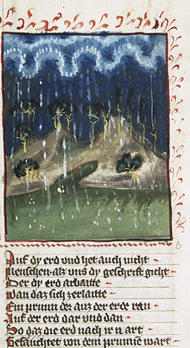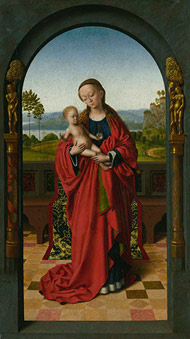 |

 |
 |
The First Rain in Paradise from the World Chronicle, German, about 1400–1410
|
 |
Landscape is such a common subject in art that we take it for granted. Yet landscape as a category of European painting emerged only during the Renaissance.
This exhibition looks at the aspects of nature that captivated manuscript illuminators during the Renaissance—the garden, water, light, the horizon, atmosphere, and the bird's-eye view. Water falls from the heavens in this early and rare depiction of rain. It illustrates the story from Genesis of the first rain in Paradise following the seven days of the creation of the World.
|
 |
|
Throughout much of the Middle Ages, artists emphasized figures at the expense of setting. Beginning in the late 1300s, however, artists took a new interest in the observation of nature and the poetic character of natural surroundings.
This miniature shows the shift toward including natural details in depictions of settings. The artist filled the image with many closely observed details: the movement of the water, a blue sky with a distant horizon bathed in an atmospheric haze, mountains and a precipitous rocky island. The tiny island of Patmos recedes dramatically into space, while the sea extends further still.
|
 |
|
The garden is landscape cultivated for human pleasure. During the Renaissance, the garden was a prominent feature of aristocratic estates. In art, the garden was also used allegorically, for example to represent love in the popular theme of the garden of love.
The garden was also an important theme in literature, starting with the biblical garden of Eden as depicted in this representation of the temptation of Adam and Eve.
|
 |
|
Seas, lakes, rivers, and streams have long inspired painters and poets. In the Middle Ages, water also played a practical role. Traversing lakes, fording rivers, and voyaging upstream were regular features of travel.
From the 1200s into the 1500s, artists began to take an interest in capturing the transparency and movement of water. Flemish painter Lieven van Lathem took particular delight in depicting bodies of water, such as the meandering river in this image of Christ appearing to Saint James the Greater.
|
 |
|
European painters and illuminators of the 1400s shared an interest in depicting light. Artists in northern Europe were particularly adept at capturing reflections and nighttime light effects.
Troops advance on a town at sunrise in this image by the Master of the Getty Froissart, which illustrates an account of the Hundred Years' War. Daylight's first rays bounce off metallic armor, illuminate windswept clouds, and reflect the arches of a bridge in the river.
|
 |
|
An angel within a golden aureole appears to shepherds in this miniature, which has a range of nocturnal light effects. The light in the windows on a distant hilltop reveals the manger where the Christ child was born.
A column of golden angels floating above the manger underscores its divine significance. Only a glimmer of moonlight at the upper right penetrates the thick clouds over the hills of Bethlehem in the background.
|
 |
 |

 |
 |
Virgin and Child in an Archway, Petrus Christus, about 1450–1455
Szépmüvészeti Múzeum, Budapest
|
 |
Perhaps the most innovative feature of landscape painting in the 1400s and 1500s was the conception of landscape as a vast terrain with deeply receding space. Artists began to depict the distant horizon and capture the palpable atmosphere that lies between the viewer and the far distance.
In this painting, the virgin and child appear on a terrace before a verdant landscape with a body of water and blue hills. Petrus Christus painstakingly applied multiple thin layers of transparent glaze to create the atmospheric haze that infuses the water and the hills with the blue of the sky.
|
 |
|
A major new feature in landscape painting of the 1500s was the bird's-eye view, a vantage point for showing the earth from the clouds. Advances in cartography in the early 1500s fueled this artistic development. So did voyages by Christopher Columbus and other explorers, which enhanced man's sense of the expansiveness of the earth.
The Crucifix seems to float high above the landscape in this large miniature from a missal, a service book for the mass. The large size of the crucified Christ, paired with the vastness of the landscape, lends universality to the meaning of his death.
|
 |
|
In the early and high Middle Ages, images of heaven, hell, and purgatory were often simplified to the point of abstraction. Artists of the later Middle Ages and the Renaissance, however, incorporated earthly perspectives into their depictions of these otherworldly landscapes.
Here the Holy Trinity is enthroned in heaven and surrounded by bands of transparent, soft color reminiscent of a rainbow. The artist situates the throne above the clouds, showing heaven from an earthly perspective. He wittily reminds us that his heaven is an illusion by showing the text, a line from a prayer, as a scrap of parchment pinned to the miniature.
The exhibition is located at the Getty Center, Museum, North Pavilion.
|
 |